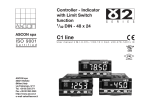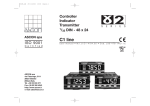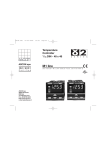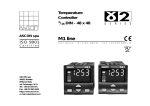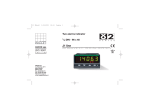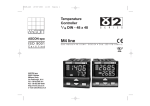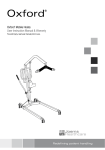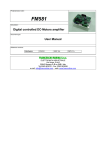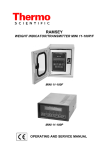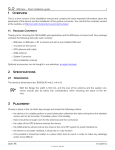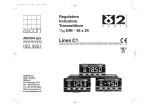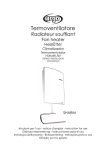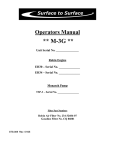Download Temperature Controller with Limit Switch Function 1
Transcript
Temperature Controller with Limit Switch function 1/ 16 DIN - 48 x 48 ASCON spa ISO 9001 C e r t i f i e d ASCON spa 20021 Bollate (Milan) Italy via Falzarego, 9/11 Tel. +39 02 333 371 Fax +39 02 350 4243 http://www.ascon.it e-mail [email protected] c M4 line User manual • M.I.U.M4L -1/03.10 • Cod. J30-478-1AM4L IE C UL LISTED US Temperature Controller with Limit Switch Function 1/ 16 DIN - 48 x 48 c M4 line C UL LISTED 4 1 2 274.8 275.0 RST US Information c NOTES ON ELECTRIC SAFETY AND ELECTROMAGNETIC COMPATIBILITY Please, read carefully these instructions before proceeding with the installation of the controller. Class II instrument, for indoor use only. This controller has been designed with compliance to: Regulations on electrical apparatus (appliance, systems and installations) according to the European Community directive 73/23/EEC amended by the European Comunity directive 93/68/EEC and the Regulations on the essential protection requirements in electrical apparatus EN610101 : 93 + A2 : 95. Regulations on Electromagnetic Compatibility according to the European Community directive n° 89/336/EEC, amended by the European Community directive n° 92/31/EEC, 93/68/EEC, 98/13/EEC and the following regulations: - Regulations on RF emissions: EN61000-6-3: 2001 residential environments EN61000-6-4: 2001 industrial environments - Regulation on RF immunity: EN61000-6-2: 2001 industrial equipment and system It is important to understand that it’s responsibility of the installer to ensure the compliance of the regulations on safety requirements and EMC. Reapirs: this device has no user serviceable parts and requires special equipment and specialised engineers. Therefore, a repair can be hardly carried on directly by the user. For this purpose, the manufacturer provides technical assistance and the repair service for its Customers. Please, contact your nearest Agent for further information. All the information and warnings about safety and electromagnetic compatibility are marked with the B sign, at the side of the note. 2 Table of contents TABLE OF CONTENTS 1 2 3 4 5 6 INSTALLATION .............................................................................................................................Page ELECTRICAL CONNECTIONS.......................................................................................Page PRODUCT CODING ................................................................................................................Page OPERATIONS................................................................................................................................Page LIMIT SWITCH FUNCTIONS ...........................................................................................Page TECHNICAL SPECIFICATIONS .....................................................................................Page 1 10 15 19 32 37 Operating mode Resources Limit Switch Supervisory Switch Main universal input PV OP1 IL OP2 Digital input (option) OP1 OP2 M4 Digital Input connected functions LIMIT SWITCH RESET Modbus RS485 Parameterisation Supervision (option) 3 1 - Installation 1 INSTALLATION 1.1 GENERAL DESCRIPTION Installation must only be carried out by qualified personnel. IP 20 Terminal Block EN61010 - 1 (IEC1010 - 1) Before proceeding with the installation of this controller, follow the instructions illustrated in this manual and, particularly the installation precautions marked with the B symbol, related to the European Community directive on electrical protection and electromagnetic compatibility. B To prevent hands touching metal parts that may be electrically live, the controller must be installed in an enclosure and/or in a cubicle. Panel surface Product code label Mounting clamps Sealing front panel gasket 4 Front panel IP65 protection EN 60529 (IEC 529) 1 - Installation 1.2 DIMENSIONAL DETAILS 1.2.1 PANEL MOUNTING MODELS Instrument dimensions Panel cut-out 65 mm min. 2.56 in min. 48 mm 1.89 in 45+0.6 mm 1.78+0.023 in 20 mm max. 0.79 in max. 65 mm min. 2.56 in min. 48 mm 1.89 in 45+0.6 mm 1.78+0.023 in 120 mm 4.72 in 5 1 - Installation 1.2.2 DIN RAIL MOUNTING MODELS Instrument dimensions 78.5 mm max. 3.1 in max. 87.5 mm max. 7.4 in max. RST 188 mm max. 7.4 in max. 6 1 - Installation B 1.4 ENVIRONMENTAL RATINGS Operating conditions M T %Rh Altitude up to 2000 m Temperature 0… 55°C Relative humidity 5… 95 % non-condensing Special conditions M T %Rh P Altitude > 2000 m Temperature >55°C Use 24V~ supply version Use forced air ventilation Humidity > 95% Warm up Conducting atmosphere Use filter Forbidden Conditions C E Suggestions D Corrosive atmosphere Explosive atmosphere 7 1 - Installation 1.5 INSTRUMENT MOUNTING 1.5.1 PANEL MOUNTING MODELS [1] Instrument insertion Installing the locking clamps Clamps removing 1 Prepare panel cut-out; 2 Check front panel gasket position; 3 Insert the instrument through the cut-out. 1 Fit the mounting clamps; 2 Push the mounting clamps towards the panel surface to secure the instrument. 1 1 Insert the screwdriver in the clips of the clamps; 2 Rotate the screwdriver. 1 2 1 2 3 2 UL note [1] For Use on a Flat Surface of a Type 2 and Type 3 ‘raintight’ Enclosure. 8 1 1 - Installation 1.5.2 DIN RAIL MOUNTING MODELS Instrument installation Instrument removal 1 Hook the “A” portion of the instrument socket to the DIN rail. 1 Press the lower part of the DIN rail socket; when “D” part of the socket frees from the rail, the instrument can be removed by rotating the higher part as indicated. A A 1.5.4 INSTRUMENT B UNPLUGGING The instructions that follow are valid for both the panel and DIN rail mounting models. 1 Push and 2 pull to remove the instrument. 1 1 Rotate D 2 1 2 Press the lower part of the socket in direction “B”. As part “C” is locked to the DIN rail, the instrument is correctly installed. 1MΩ Electrostatic discharges can damage the instrument. Press Before removing the instrument the operator must discharge himself to ground. C B 9 2 - Electrical connections N 2 8 mA mV C 4 10 B 5 11 b 6 12 RTD 14 15 NO 9 A IL (OPT.) TC NO 3 13 16 C OP2 relay 1 7 OP1 L RS485 (OPT.) ELECTRICAL CONNECTIONS OP2 logic 2 17 B 2.1 TERMINAL BLOCK [1] 1 7 13 2 8 14 9 15 4 10 16 5 11 17 6 12 18 3 0,5 Nm Rear terminal cover 18 5.7 mm 0.22 in Cable size 1 mm2 (18 AWG) 18 screw terminals Terminals Option terminals Tightening torque 0.5 Nm UL note [1] Use 60/70 °C copper (Cu) conductor only. 10 Positive screw driver PH1 Negative screw driver 0,8 x 4 mm Ø L Pin connector q 1.4 mm 0.055 in max. Fork-shape AMP 165004 Ø 5.5 mm - 0.21 in Stripped wire L 5.5 mm - 0.21 in 2 - Electrical connections PRECAUTIONS B Despite the fact that the instrument has been designed to work in an harsh and noisy environmental (level IV of the industrial standard IEC 801-4), it is recommended to follow the following suggestions. B 2.2 SUGGESTED WIRES ROUTING Conduit for supply and output cables B A B BB A B A All the wiring must comply with the local regulations. The supply wiring should be routed away from the power cables. Avoid to use electromagnetic contactors, power Relays and high power motors nearby. Avoid power units nearby, especially if controlled in phase angle Keep the low level sensor input wires away from the power lines and the output cables. If this is not achievable, use shielded cables on the sensor input, with the shield connected to earth. C 1 L 7 13 1 L 7 13 2 N 8 14 2 N 8 14 3 9 15 3 9 15 4 10 16 4 10 16 5 11 17 5 11 17 6 12 18 6 12 18 ED C ED A = Power Supply B = Outputs C = Analog inputs D = Serial Comm.s E = Digital input/output Conduit for low level sensor cables 11 2 - Electrical connections B 2.3 EXAMPLE OF WIRING DIAGRAM Power supply V Supervisor ~ Power supply switch 2.3.1 POWER SUPPLY [3] RX/TX RS485 PTC [4] 1 7 13 2 8 14 3 9 V~ Fuse [5] V ~ [6] OP1 OP2 logic 15 IL (opt.) OP2 4 10 5 11 17 6 12 18 Fuse [5] [6] V 16 ~ Alarm TC Notes: 1] Make sure that the power supply voltage is the same indicated on the instrument. 2] Switch on the power supply only after that all the electrical connections have been completed. 3] In accordance with the safety regulations, the power supply switch shall bring the identification of the relevant instrument. The power supply switch shall be easily accessible from the operator. 4] The instrument is PTC protected. In case of failure it is suggested to return the instrument to the manufacturer for repair. 5] To protect the contacts of the relay outputs (OP1 and OP2) use a 2 A~ T (220 V~) or a 4 A~ T (120 V~) . 6] Relay contacts are already protected with varistors. Only in case of 24 V~ inductive loads, use model A51-065-30D7 varistors (on request). 12 B Switching power supply with multiple isolation and PTC protection. • Standard version: nominal voltage: 100... 240V~ (-15%/+10%); frequency: 50/60Hz. • Low Voltage version: nominal voltage: 24V~ (-25%/+12%); frequency: 50/60Hz or 24V– (-15%/+25%). • Power consumption: 2,6W max. Included PTC L 1 Supply N 2 2 - Electrical connections B 2.3.2 PV CONTROL INPUT A For L-J-K-S-T thermocouple type • Connect the wires with the polarity as shown. • Use always compensation cable of the correct type for the thermocouple used. • The shield, if present, must be connected to a proper earth. D mV mA R1 + R2 must be <320Ω 5 5 6 Wire resistance 150Ω max. 6 External Shunt 2.5Ω 2.3.3 DIGITAL INPUT (option) B For Pt100 resistance thermometer • If a 3 wires system is used, use always cables of the same section (1mm2 min.) (line 20 Ω/lead maximum resistance). • When using a 2 wires system, use always cables of the same section (1,5mm2 min.) and put a jumper between terminals 5 and 6. C For ∆T (2x RTD Pt100) Special A When the distance between the controller and the sensor is 15 m using a cable of 1.5 mm2 section, produces an error on the measure of 1°C. For mA, mV B 5 b 6 A 12 For 3 wires only 20 Ω/lead max. resistance Rj >10MΩ B • The input is active when the logic state is ON, corresponding to the contact closed. • The input is inactive when the logic state is OFF, corresponding to the contact open. • The digital input allows to perfom a Limit switch reset. NPN open collector C1 IL 9 A 5 R1 R2 B A 6 12 Use wires of the same length and 1.5 mm2 size. 20 Ω/lead max. resistance. 10 11 Com. Isolated contact TTL open collector 13 2 - Electrical connections 2.3.3 OP1 - OP2 OUTPUTS B LIMIT SWITCH RELAY OUTPUT (OP1) OP2 output can be Relay (Std) or SSR drive. The jumper on the auxiliary board selects the output type: - Short Pins 1-2 for OP2-Relay; - Short Pins 2-3 for OP2-Logic. Single relay output • NO contact for resistive load of up to 2A/250V~ max. or 4 A~ T at 120 V~; • Fuse: 2A~ T at 250 V~ or 4 A~ T at 120 V~ (IEC 127). B Single relay output • NO contact for resistive load of up to 2A/250V~ max. or 4 A~ T at 120 V~; • Fuse: 2A~ T at 250 V~ or 4 A~ T at 120 V~ (IEC 127). Fuse 15 OP2 Jumper 3 2 1 16 Fuse 3 Auxiliary board Load OP1 Varistor for inductive load 24V~ only 4 Load Varistor for inductive load 24V~ only SUPERVISORY SWITCH RELAY OR LOGIC B OUTPUT (OP2) SSR drive output not isolated • 0… 5V–, ±20%, 30 mA max. 10 OP2 11 14 Static relay 2.3.8 SERIAL COMMUNICATIONS (option) B • Galvanic isolation 500V~/1 min. • Compliance to the EIA RS485 standard for Modbus/Jbus. 7 8 Load A Please, read the user manual: “M4 serial communications and configuration software”. 3 - Product coding 3 PRODUCT CODING The complete code is shown on the instrument label. The informations about product coding are accessible from the front panel by means of a particular procedure described at section 4.2.2 page 21 4 1 2 3190 Hard Instrument Label P/N CONF S/N V~(L-N) : M4-3190-9000 : 2120-0200 : A0A-0328/2962 :100... 240V 50/60 Hz- 2,6W RST C O B C D L M N P Q R UL US LISTED IND.CON.EQ 23 FA Basic product code (hardware) Configuration code (software) 15 3 - Product coding 3.1 MODEL CODE The product code indicates the specific hardware configuration of the instrument, that can be modified, by specialized engineers only. Line Model: M 4 Basic Accessories A 1 C 0 - 9 F G H Line M 4 Power supply 100 - 240V~ (- 15% + 10%) 24V~ (- 25% + 12%) or 24V– (- 15% + 25%) A 3 5 Serial Communications Not fitted RS485 Modbus/Jbus protocol Digital input C 0 5 9 User manual Italian/English French/English German/English Spanish/English F 0 1 2 3 Front bezel colour Dark grey (std) Beige Dark grey (std) Beige 0/4... 20 mA Input shunt resistor [1] Standard resistor Standard resistor High accuracy resistor High accuracy resistor Mounting Panel mounting (standard) DIN rail mounting with display 16 G 0 1 2 3 H 0 1 Notes: 1] Standard shunt resistor without field calibration will provide: 1.10% input accuracy for 0/4...20 mA input. High accuracy shunt resistor without field calibration will provide: 0.20% input accuracy for 0/4... 20 mA input. Both shunt resistors with field calibration will provide 0.10% input accuracy for 0/4... 20 mA input. 3 - Product coding 3.2 CONFIGURATION CODING The configuration code consists of 8 digits that identify the operating characteristics of the controller, as chosen by the user. Paragraph 4.6 at page 30 reports the instructions how to set a new configuration code. 1st part of configuration code I L M N 2120 Conf 2nd part of configuration code O P Q R 0200 Com2 The configuration code can be displayed on the front panel, following the instructions at paragraph 4.2.2 page 22. Input type and range TR Pt100 IEC751 TR Pt100 IEC751 TC L Fe-Const DIN43710 TC J Fe-Cu45% Ni IEC584 TC T Cu-CuNi TC K Chromel -Alumel IEC584 TC S Pt10%Rh-Pt IEC584 DC input 0…50 mV, linear DC input 10…50 mV, linear Custom input and range -99.9…300.0 °C -200…600 °C 0…600 °C 0…600 °C -200 …400 °C 0…1200 °C 0…1600 °C Engineering units Engineering units -99.9…572.0 °F -328…1112 °F 32…1112 °F 32…1112 °F -328…752 °F 32…2192 °F 32…2912 °F I 0 1 2 3 4 5 6 7 8 9 Value shown on the lower display in operator mode Limit switch alarm (AL1) threshold Supervisory switch alarm (AL2) threshold L 1 2 Alarm 1 (AL1) Limiter Power-ON condition Automatic reset Manual reset Status retention M 0 1 2 AL1 function High limiter Low limiter N 0 1 Digital input [1] AL1 Acknowledge enabled AL1 Acknowledge disabled O 0 1 Note [1] This code must be 1 when the serial communication option is not present in the istrument. 17 3 - Product coding A If, when the controller is powered ON for the first time, the display shows the following message: 4 1 2 3 9999 Conf Alarm 2 (AL2) type and function Not active Sensor break alarm Active high Absolute Active low Active high Deviation Active low Active out Band Active in P 0 1 2 3 4 5 6 7 AL2 action Direct Reverse Q 0 1 AL2 reset Auto Manual R 0 1 RST it means that the controller has not been configured yet. The controller remains in stand-by until the configuration code is set correctly (see chapter 4.6 page 35). 18 4 - Operations 4 OPERATIONS 4.1 OPERATOR PANEL 4.1.1 KEYS FUNCTIONS AND DISPLAY IN OPERATOR MODE IN input value in engineering units When the measured value is greater than sensor high range Output status LEDs (red): Limit switch status Supervisory switch When the measured value is less than the sensor low range Limit & Supervisory threshold in engineering units 4 1 2 274.8 275.0 Menu access & Supervisory switch Acknowledge RST Limit switch Reset button & Enter key for selection and value setting 4.1.2 KEYS FUNCTIONS AND DISPLAY IN PROGRAMMING MODE 4 Parameter value 35.0 1 2 Conf Parameter name (mnemonic code) A/M Access to the menu for: - Configuration; - Parameter setting; - Set point setting RST Enter key for selection and value setting confirmation Values modification 19 4 - Operations 4.1.3 OPERATOR INTERFACE During normal operation the instrument is in Operator Mode: the upper display shows the Process Value (IN) in engineering units and the lower display shows the current setting for AL1 or AL2 threshold. The limiter can be configured to show the AL1 threshold on the lower display (configuration code L=1). Pressing the up or down keys the AL2 threshold will be displayed for 5 seconds. The limiter can be configured to show the AL2 threshold the lower display (configuration code L=2). In this case, pressing the up or down keys the AL1 threshold will be displayed for 5 seconds. 20 Any operator operation other than limiter AL1 acknowledge (è key) or auxiliary AL2 acknowledge (Y key) when the AL2 is configured, is protected by password access. Pressing the RESET key (è) during normal operation has no effect. During normal operation, pressing the menu access key (Y), and introducing the correct password value, the Operator can enter in Programming Mode to set parameters and configure the instrument. 4 - Operations 4.2 DISPLAY When the display operation is selected, the controller presents automatically all the most important parameters and configuration information. During the operation, the parameters values cannot be modified by the user After 2 seconds from the end of the operation, the controller returns to the normal operating conditions. 4.2.1 PROCESS DATA DISPLAY 274.8 275..0 °C Unit 274.8 In Operator mode Engineering units [1] 275.0 AL1 Threshold 250.0 AL2 Threshold A1s.p A2s.p Input Value Note [1] See table page 31 21 4 - Operations 4.2.2 CONFIGURATION CODES DISPLAY When necessary, the operator can view the instrument main data (no changes are possible with the present procedure). 274.8 275.0 274.8 °C Operator mode Engineering units [1] Con2 00A rel. Configuration code 2nd part (see page 18) Software release 3190 Basic product code (see page 16) 275.0 AL1 Threshold 2120 Configuration code 1st part (see page 17) 250.0 AL2 Threshold Hard Conf Example: M4 - 3190 - 2120 / Release 00A Note [1] See table page 31 22 0200 A1S.P A2s.p 4 - Operations 4.3 PARAMETER SETTING 4.3.1 NUMERIC ENTRY (e.g. the modification of the AL1 threshold from 275.0 to 240.0) Press S or G momentarily to change the value of 1 unit each time the key is pressed. Pressing the S or G key for a longer time changes the value, at rate that doubles every second. Releasing the button the rate of change decreases. In any case the change of the value stops when it has reached the max./min. limit set for the parameter. 274.8 275.0 é Operator mode Input value and AL1 threshold displayed 0 275.0 A1s.p Value modification Lower pAss Password entry 250.0 A1s.p Rise 33 Code entry 0000... 9999 Must be equal to the value of the parameter Code (factory default 33) 260.0 A1s.p Value modification New value (the displayed value is stored by the instrument only pressing the è key) OK To the next parameter A2SP 23 4 - Operations 4.3.2 MNEMONIC CODES SETTING (e.g. configuration see page 30) Pressing istantaneously the $ or % key, the system shows the next or the previous mnemonic code of the selected parameter. Pressing the $ or % keys for a longer time causes the system to show the further mnemonic codes at a rate of one every 0.5 s. The mnemonic code displayed at the time the next parameter is selected using the è key, is the one stored in the parameter. Engineering Units °C Unit °f Unit °C Unit 24 Degrees Centigrade Degrees Fahrenheit Degrees Centigrade °f Unit none Unit ph Unit Degrees Fahrenheit no units defined Ph 4 - Operations 4.4 PARAMETERISATION A The parameter setting procedure has a timeout. If no keys are pressed for, at least, 30 seconds, the controller switches back, automatically, to the operator mode. After having selected the parameter or the code, press $ and % to display or modify the value (see page 23). The value is entered when the next parameter is selected, by pressing the è key. Parameter mnemonic code Parameter value M4 275.0 A1S.P RST Values modification Parameter menu selection Modification/ selection enter 25 4 - Operations 274.8 275.0 Operator mode pAss 33 Password entry Code entry 0000... 9999 Must be equal to the value of the parameter Code (factory default 33) OK NO YES Notes [1] Not presented if the controller has been configured as: AL2 not active or sensor break (configuration code P = 0 or 1) [2] When the AL2 alarm is configured as “Sensor Break” (configuration code P = 1) the only choices available are: None and Latching. 26 4 - Operations PARAMETER MENU é 0 A1s.p é 0.5 é A1hy énone A2L.b 0 A2S.P é Off In.sh AL1 hysteresis 0.1… 10.0% of span 0:5 A2hy é Limit switch threshold (see page 28) é AL2 hysteresis [1] 0.1… 10.0% of span AL2 Latching and blocking functions [2] none / ltch bloc / lt..bl 1 Addr Supervisory switch threshold [1] (see page 28) Input shift (OFF/-60... +60 digits Communication address (if option installed) 0ff/ 1… 247 Direct access to: Conf é OFF time constant t.Fil Filter OFF/1... 30 s 27 4 - Operations 4.5 PARAMETERS AL1 Limit Switch threshold Threshold value that triggers the limit switch alarm condition. In engineering units. #A1s.p AL2 Supervisory threshold The alarm occurrences handle the OP2 output in different ways, according to the configured alarm types, as illustrated: #A2s.p Sensor failure (break, disconnection etc.) Sensor PT100 Wire A open Wires A and B in short circuit, wire b open All other conditions Thermocouple All conditions Analog input Short circuit between the wires All other conditions On Off Over-range Under-range Over-range hy Low range Alarm threshold High range Deviation alarm - AL2 On Active Off high AL2 threshold On Off Active low hy - low range Alarm threshold 28 On Off hy hy On Active Off out Active in Full scale Alarm threshold Active low under-range AL2 threshold Full scale On Active Off high over-range If a sensor failure occours, the instrument detects and displays an overrange or under-range input condition as specified in the following table. Over-range Over-range for a while, then under-range Under-range Absolute alarm (full scale )- AL2 Visualisation T Band alarm - AL2 + high range Absolute alarm is referred to AL2 threshold, while deviation and band alarms are referred to AL1 threshold. If Direct action is selected for AL2 (configuration code Q=0), OP2 output will be activated during AL2 condition; if Reverse action is selected (configuration code Q=1), OP2 output will be released during AL2 condition. Only OP2 action can be configured, limiter function on OP1 operates only in fail safe mode. AL2 reset function is only effective if latching has been selected for AL2 output. If Auto is selected (configuration code R=0), AL2 reset will be performed after acknowledgement and exiting from the alarm condition. If Man is selected (configuration code R=1), acknowledgement will reset AL2 regardless to the alarm condition. 4 - Operations A # 1hy A # 2hy AL1 limit switch hysteresis AL2 supervisory switch hysteresis Hysteresis of the threshold of both the alarms, that activate OP1 and OP2 control output. It is specified as a % of the full scale. AL2, latching and blocking functions For AL2 alarm it is possible to select the following functions: #A2L.b none Ltch bloc lt.bL l # tch none latching blocking both latching and blocking AL2 ACKNOWLEDGE FUNCTION The alarm, once occurred, is presented on the display until to the time of acknowledge. The acknowledge operation consists in pressing the Y key. After this operation, the alarm leaves the alarm state only when the alarm condition is no longer present. b # loc ALARM_2 START-UP DISABLING Ramp down (e.g.: AL2 Abs. high) Disable AL2 Th. AL2 ON AL2 OFF Ramp up (e.g.: AL2 Abs. low) Disable AL2 ON AL2 OFF Input shift This value is added to the measured input value (IN). Its effect is to shift the whole PV scale of up to ±60 digits. Controller address the address range is from 1 to 247 and must be unique for each controller on the communication bus to the supervisor. When set to Off, the controller is not communicating. A # ddr Power ON AL2 Th. #In.sh Power ON Not available when sensor break is selected for AL2. Input filter time constant Time constant, in seconds, of the RC input filter applied to the PV input. When this parameter is set to Off the filter is bypassed. #t.fil Filter response 100% 63,2% 0 t.Fil PV Time 29 4 - Operations 4.6 CONFIGURATION The configuration of the controller is specified through a 8 digit code that defines the type of input and alarms. (paragraph 3.2 page 17) Parameter value 274.8 275..0 pAss Password entry Operator mode 33 Code entry 0... 9999 Must be equal to the value of the parameter Code Parameter mnemonic code NO (factory default 33) OK YES M4 200.2 Conf RST Values modification Configuration Enter key for menu access selection and value setting confirmation Press $ or % to display the next parameter or the next code and to change its value. The new value entered is stored into the controller when the next parameter is selected by pressing è. 30 prot Communication protocol (only if communication is installed) M.bu5 / jbus baud Baude rate (only if comm. is installed) Code Password 0…9999 33 factory default To A1S.P 1200/2400 4800/9600 Unit Engineering units (see table 1) sc.d.d N° of decimals (linear scales only) 0…3 sc.lo Low range [1] (linear scales only) -999…9999 sc.Hi High range [1] (linear scales only) -999…9999 4 - Operations CONFIGURATION MENU A [1] Table of the supported Engineering Units. Direct access to the configuration Centigrade degrees * A From parameterisation (see page 28). B At the first power on when the controller is not configured: 9999 Press è until “CoNF” appears Conf In this situation, the controller has its outputs and inputs not active. This situation ends when a correct configuration code is entered. Entry of digits I-L-M-N of the configuration code (paragraph 3.2 page 17) Fahrenheit degrees * none mV Volt mA Ampere Bar PSI Rh I L M N pH 2120 Conf O P Q R 0200 Con2 °C °f none nU U MA A bAr psI rh ph * For inputs from thermocouple or resistance thermometer, the choice is between °C and °F only. [2] Range of min 100 digits. [3] To return to the operator mode press, from any position, the Y key. Entry of digits O-P-Q-R of the configuration code (paragraph 3.2 page 18) 31 5 - Limit Switch Function 5 LIMIT SWITCH FUNCTION In order to have the limit switch function the product code must be similar to te one that follows: M4 3190-9000 5.1 LIMIT SWITCH FUNCTION (ALARM_1) The limiter can operate as a high limiter or low limiter. Only output relay OP1 can be used as limit switch. The limiter output relay OP1 is energized (contact closed) during normal operation and is de-energized (contact open) when the alarm is activated or when a power failure occurs (fail safe mode). If “High limiter” is selected (configuration code N=0), the limiter will go in alarm condition when the input exceeds the alarm threshold or when a failure of the input occurs. If “Low limiter” is selected (configuration code N=1), the limiter will go in alarm condition when the input drops below the alarm threshold or when a failure of the input occurs. Then, after an alarm occurred, when the input retur ns to a normal value (i.e. drops below the AL1 threshold for high limit, or rises above AL1 threshold for low 32 limit), the OP1 relay will remain de-energized with the contact open until the operator manually acknowledges the alarm by either of two methods: - Pressing the “Enter key” (è RST) on the front panel of the limiter or - Closing the digital input “IL” (if the option is available and this function is enabled). LED1 will: - Flash when a new non-acknowledged alarm occurs; - Remain steady ON when the AL1 is acknowledged but still exists. 5 - Limit Switch Function The complete operation mode is detailed in the table that follows: Limiter status OP1 contact Non alarm status Energized (contact closed) Led 1 OFF Non-ackowledged De-energized status (contact open) Flashing Ackowledged status Steady ON De-energized (contact open) Limiter can change status by: Input conditions Normal operation AL1 condition Stays in non Transition to alarm status non-acknowledged status Reset Ack Transition to acknowledged status Non-Ack Stays in non-acknowledged status Input conditions Normal operation AL1 condition Returns to non Stays in acknowledged alarm status status If “Digital Input AL1 Ack enable” is selected (configuration code O=0), the digital input will be logic OR with the reset key (è), for acknowledge AL1. Selecting “Digital Input AL1 Ack enable” (configuration code O=1), the digital input will have no function (page 17). 33 5 - Limit Switch Function The limiter has a Status Retention capability, it only applies to the Limiter AL1 and OP1 output status. If the limiter is configured for the Status Retention and the power is switched ON, the limiter will operate as detailed in the table that follows: OP1 Relay Limiter Status at previous Input AL1 condition at new Limiter Status at new LED 1 contact power OFF power ON power ON Non alarm status Close Normal operation Non Alarm status Steady OFF (normal operation) Open Alarm condition true Non Acknowledged alarm Flashing Non Ancknowledged alarm Normal operation Non Acknowledged alarm Open Flashing Normal operation Non Alarm status Close Steady OFF Alarm condition true Acknowledged alarm Open Steady ON Alarm condition true Ancknowledged alarm If “Automatic Reset” is selected (configuration code M =0), at power ON, the limiter status will depend on the input value (i.e.: if at power ON the input value is in the safe operating range, the limiter automatically will enter in non-alarm status. If “Manual reset” is selected (configuration code M =1), at power ON, the limiter status will be forced to Non-acknowledged Alarm. If “Status retention” is selected (configuration code M=2), at power ON, the limiter status will be forced to the status of the limiter at previous power down time, as described in the table. Status retention does not apply to any condition regarding AL2 (AL2 operation at power ON depends on input value). 34 5 - Limit Switch Function 5.2 SUPERVISORY SWITCH (AL2) The OP2 relay output contact is used as a normal auxiliary alarm (AL2). AL2 operation is configurable and independent from the operation of the limiter output OP1. Configuration allows an operator to choose the alarm type, OP2 action, automatic reset/latching. LED 2 indicates Alarm 2 status. For AL2 output no status retention mode is available (status data storing). AL2 Reset = Auto AL2L.b = Latching or Latching + Blocking Status # 0 1 2 OP2 contact Description Non alarm Non-ackowledged alarm Ackowledged alarm AL2 Reset = Man 0 1 2 OFF ON ON OFF No transition Flashing ON Transition to 0 OP2 contact AL2 LED Description Non alarm Alarm Silence Status transition Input Operator acknowledgment Alarm No Yes Non alarm condition condition Transition to 1 No transition Transition to 2 No transition AL2L.b = Latching or Latching + Blocking Status # AL2 LED OFF ON OFF OFF ON OFF Status transition Input Operator acknowledgment Non alarm Alarm No Yes condition condition No transition Transition to 1 No transition Transition to 0 Transition to 2 No transition 35 5 - Limit Switch Function AL2 Reset = Man AL2L.b = None or Blocking Status # 0 1 2 OP2 contact AL2 LED Description Non alarm Alarm Silence OFF ON OFF OFF ON OFF Status transition Input Operator acknowledgment Yes Non alarm Alarm No condition condition No transition Transition to 0 Transition to 0 Transition to 1 No transition No transition No transition Transition to 2 AL2 Reset = Auto AL2L.b = None or Blocking Status # 0 1 2 36 OP2 contact AL2 LED Description Non alarm Alarm OFF ON OFF ON Status transition Input Operator acknowledgment Yes Non alarm Alarm No condition condition No transition Transition to 0 Transition to 1 No transition 6 - Technical Specifications 6 TECHNICAL SPECIFICATIONS Features (at 25°C environmental temp.) Description PV Input (see pages 11,12 and 18) Common characteristics A/D converter resolution: 50,000 points Update measurement time: 0.2 seconds Sampling time: 0.5 seconds Input bias: -60… +60 digit Input filter with enable/disable: 1… 30 seconds Accuracy 0.25% ±1 digit for temperature sensors 0.1% ±1 digits for mV Between 100… 240V~ 0.1% ±1 digits +the accuracy of the external shunt the error is minimal resistor for mA Resistance thermometer (for ∆T: R1+R2 must be <320Ω) Pt100Ω at 0°C (IEC 751) °C/°F selectable Thermocouple L,J,T,K,S (IEC 584) Rj >10MΩ °C/°F selectable Internal cold junction compensation in °C/°F 4…20mA, 0... 20mA with external shunt 2.5Ω Rj >10MΩ 10… 50mV, 0... 50mV Rj >10MΩ Engineering units Conf. decimal point position Input drift: <0.1% / 20°C Init. Sc -999…9999 Environmental Full Sc. -999…9999 Temperature (min. range of 100 digits) DC input (current) DC input (voltage) Max. wire Res: 20Ω max (3 wires) 2 or 3 wires connection Input drift: 0.35°C/10° Tenv.. <0.35°C/10Ω Wire Res. Line: 150Ω max. Input drift: <2µV/°C env. temperature <5µV/Ω line resistance 37 8 - Technical specifications Features (at 25°C environmental temp.) Description Digital input (option) The closure of the external contact produces the acknowledgment of AL1 (if the function is enabled) OP1 output SPST Relay N.O.: 2A/250V~ for resistive load; 4A/120V~ for resistive load OP2 output SPST Relay N.O.: 2A/250V~ for resistive load; 4A/120V~ for resistive load; SSR drive not isolated:5V–, ±10%, 30 mA max. Serial comm. (option) Operational safety General characteristics 38 RS485 isolated, Modbus/Jbus protocol, 1200, 2400, 4800, 9600 bit/s, two wires Detection of out of range, short circuit or sensor break with automatic activation Measure input of the safety strategies and alerts on display Parameter and configuration data are stored in a non volatile memory for an unlimited time Access protection A password protects the access the instrument configuration Parameters Power supply (PTC protected) 100... 240V~ (-15... +10%) 50/60 Hz or 24V~ (-25... +12%), 50/60 Hz and 24V– (-15... +25%) Power consumption 2,6 W max. Electrical Safety Compliance to EN61010-1 (IEC 1010–1), installation class 2 (2500V), pollution class 2, class II instrument Electromagnetic compatibility Protection Compliance to the CE standards (see page 2) Approvals UL, cUL file N° 176452; Factory Mutual Class 3545 Note: The UL label on the limit switch is for regulatory use only. Dimensions 1/ 16 IP65 front panel EN60529 (IEC 529) DIN - 48 x 48, depth 120 mm, weight 130 g approx. Warranty 1 WARRANTY We warrant that the products will be free from defects in material and workmanship for 3 years from the date of delivery. The warranty above shall not apply for any failure caused by the use of the product not in line with the instructions reported on this manual. 39 ASCON’S WORLDWIDE SALES NETWORK SUBSIDIARY GERMANY FRANCE MESA INDUSTRIE ELEKTRONIK GMBH Phone +49 2365 915 220 Fax +49 2365 915 225 ASCON FRANCE Phone 0033 1 64 30 62 62 Fax 0033 1 64 30 84 98 AGENCE SUD-EST Phone 0033 4 74 27 82 81 Fax 0033 4 74 27 81 71 DISTRIBUTORS GREECE CONTROL SYSTEM Phone +30 31 521 055-6 Fax +30 31 515 495 BRANCH OFFICE Phone +30 1 646 6276 Fax +30 1 646 6862 ARGENTINA HOLLAND MEDITECNA S.R.L. Phone +5411 4585 7005 Fax +5411 4585 3434 HSD INSTRUMENTS Phone +31 78 617 03 55 Fax +31 78 618 26 68 AUSTRALIA PORTUGAL IPA INDUSTRIAL PYROMETER (AUST) PTY.LTD Phone +61 8 8352 3688 Fax +61 8 8352 2873 REGIQUIPAMENTOS LDA Phone +351 21 989 0738 Fax +351 21 989 0739 SPAIN FINLAND & ESTONIA TIM-TOOL OY Phone +358 50 501 2000 Fax +358 9 50 55 144 40 BRANCH OFFICE Phone +34 93 311 98 11 Fax +34 93 311 93 65 Phone +34 91 656 04 71 Fax +34 91 677 21 26 INTERBIL S.L. Phone +34 94 453 50 78 Fax +34 94 453 51 45 SWITZERLAND CONTROLTHERM GMBH Phone +41 1 954 37 77 Fax +41 1 954 37 78 TURKEY KONTROL SISTEMLERI LTD Phone +90 216 302 19 70-71 Fax +90 216 302 19 72 UNITED KINGDOM EUKERO CONTROLS LTD Phone +44 20 8568 4664 Fax +44 20 8568 4115









































